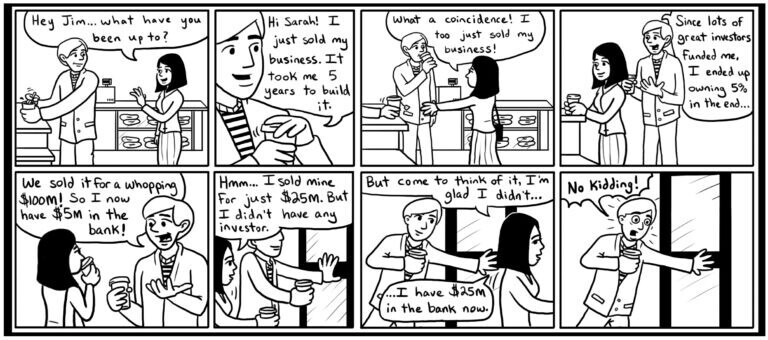Best of Bootstrapping: Serial Entrepreneur Bootstrapped Two Startups to Enormous Revenue

If you haven’t already, please study our free Bootstrapping course and the Investor Introductions page.
Oversee.net Founder and Manage.com Co-founder Fred Hsu bootstrapped two companies with huge amounts of revenue. The first, he sold to a private equity firm. The second was acquired by Criteo in 2018. We spoke in 2015, amazing story!
Sramana Mitra: Let’s get started at the beginning of your personal story. Where were your born, raised, and in what kind of environment?
Fred Hsu: I was born in Ohio. My parents were Chinese immigrants who came to the States for graduate school. They had moved to Taiwan during the communist takeover. I have an older sister. She was born in Virginia. I also have a younger brother who was born in Connecticut. We moved around a lot as kids. My dad was a defense contractor moving from one air force base to another. My mom was an accountant by trade. She fell into the insurance industry and eventually, programming.
Featured Videos
Cloud Stocks: Smartsheet Focuses on App Integrations

According to a recent report, the global enterprise collaboration market is expected to grow at 14% CAGR from $47.74 billion in 2022 to $92.41 billion by 2027. Work management platform provider Smartsheet (Nasdaq: SMAR) recently announced its third quarter results that exceeded market estimates.
>>>1Mby1M Virtual Accelerator Investor Forum: With Sergey Jakimov, Co-Founder and Partner at LongeVC (Part 4)
Sramana Mitra: Are you looking for something in this DNA testing and sequencing area that you haven’t found yet?
Sergey Jakimov: I would be looking for a merge between DNA sequencing capacity and actionable insights based on that. I would be looking at the comprehensive model where the company offers you DNA sequencing and a comprehensive report with some supplement-based insights or potential diagnostic-based insight or non-prescription interventions to mitigate risks.
>>>Video FAQs
Can 1M/1M Help Me Raise Money?
How Does 1M/1M Democratize Entrepreneurship Education?
How Does 1M/1M Democratize Management Consulting?
When Is The Right Time To Join 1M/1M?
Can 1M/1M Help Me With Business Development?
Can 1M/1M Help Me With Market Sizing?
Can 1M/1M Help Me Validate My Product?
Will I Have Private 1-on-1 Sessions In 1M/1M?
How Does 1M/1M Help Entrepreneurs Connect With Silicon Valley?
Mentoring or Consulting?
Why Does 1M/1M Charge $1000 a Year?
Why Does 1M/1M Partner With Local Organizations?
Why Don\’t Mentoring Networks Work?
Why Is It Important To Study With 1M/1M Now?
Dan Stewart Story
Vikrant Mathur Story
Best of Bootstrapping: Bootstrapped an Evergreen Business from Oregon

If you haven’t already, please study our free Bootstrapping course and the Investor Introductions page.
There is a trend among entrepreneurs wanting to keep running companies without seeking an exit. Kristin Quinlan, CEO of Certified Languages International (CLI), told us about one such evergreen company in 2015.
Sramana Mitra: Let’s start at the very beginning of your story. Where are you from? Where you born, raised, and in what kind of background?
Kristin Quinlan: I was born and raised in Portland, Oregon. I went to school at the University of Oregon. My children are also there. One is graduating from there now and my daughter is currently enrolled. They are fourth-generation University of Oregon attendees. I spent a year of my education in Amherst, Massachusetts. Other than that, it’s all been here.
1Mby1M Virtual Accelerator Investor Forum: With Sergey Jakimov, Co-Founder and Partner at LongeVC (Part 3)
Sramana Mitra: Let’s switch gears to another category. Pick another category where there is a heavy computer science element.
Sergey Jakimov: Another interesting one is digital health. If we’re talking longevity, it’s of course aging clocks and all sorts of consumer-facing risk calculators. That’s another very interesting angle of how we taught algorithms to work with clinical data or user-reported data as well as how we made it consumer-facing and consumer-digestible.
>>>Best of Bootstrapping: Bootstrapped a Highly Profitable Company in Social Media Marketing

If you haven’t already, please study our free Bootstrapping course and the Investor Introductions page.
When we spoke in 2015, Founder Jamie Tedford had bootstrapped Brand Networks to a highly profitable, large business, leveraging the disruption in brand marketing caused by social media. Excellent execution!
Sramana Mitra: Let’s start at the very beginning of your story. Where are you from? Where were you born, raised, and in what kind of background?
Jamie Tedford: I was born in a town north of Boston, Massachusetts. It’s a very typical middle-class story and family. I’m third-generation Jamie Tedford. My grandfather started a family business. He was actually an MIT alumnus. He came out of MIT during the Great Depression. He went to work for a paper company and decided to start a lumber mill. He is the first of the family that I can track back who’s an entrepreneur. The business eventually turned into a commercial lumber yard. The family stayed pretty close to home. My dad went to work for him.
Cloud Stocks: RingCentral Expands into Device as a Service

According to a recent report, the global Unified Communication as a Service (UCaaS) market is expected to grow at 14.5% CAGR to reach $85.7 billion by 2031. RingCentral (NYSE:RNG) recently announced its third quarter results that continued to surpass market expectations.
>>>1Mby1M Virtual Accelerator Investor Forum: With Sergey Jakimov, Co-Founder and Partner at LongeVC (Part 2)
Sramana Mitra: I want to double-click down on a bunch of areas that are broadly relevant to digital health. What you said about applying AI to drug discovery is of interest. Any kind of quantified health measures is also of interest.
The intersection of computer science and biology is where our audience would find the most useful insight. What is the state of the union and where are you playing? What are some of the case studies in your portfolio?
>>>